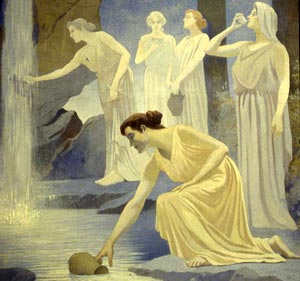 |
| The Duchesse d'Angoulême |
The Duchesse d'
Angoulême used to frequent the waters at Vichy. From
Geri Walton:
Despite critics, watering-places were prevalent across the European continent in the Georgian Era. According to one source:
“The British and Irish mineral waters noticed … exceed one hundred.
Those in France are not fewer than eighty; while Germany is richer in
these medicinal springs than either Britain or France. There are many in
Italy, Spain, Greece, Turkey, Sweden, Russia, and Switzerland.”
Mineral springs were also considered natural sources that arose from
the bosom of the earth. Several hypotheses existed as to the formation
of them, but the most general opinion in the 1830s was that they were
formed in the following manner:
“[Because of] atmospheric moisture in the form of rain and dew,
which, sinking through the cracks and fissures of the soil in
mountainous districts, penetrates deeper in the earth in proportion to
the degree of pressure of the superincumbent column of liquid, and by
its action on the different strata through which it percolates becomes
impregnated with mineral particles, acquiring a higher or lower degree
of temperatures; which some have considered referrible to the central
heat of the globe, and have endeavoured to prove that the elevation of
temperatures is in a direct ratio in the depth at which a spring
arises.”
The efficacy of a mineral spring was claimed to depend upon intimate
combinations of such things as saline, metallic, and gaseous substances
present within the water. Different watering-places also had different
amounts of minerals or salts and might contain alkaline, carbonates,
sulphate of lime, or carbonic acids. Moreover, some of the
watering-places had turbid water or it was colored by various
substances. The smell and taste of the waters was often characteristic
of a particular spring, and, so, for example, “an inky, astringent taste
[was] peculiar to chalybeate springs.”
Mineral springs were discovered in different ways. For example,
several highly efficacious springs were claimed to have been discovered
because of diseased animals. Diseased animals supposedly instinctively
drank from the waters to aid in their recovery, and several specific
cases of animals enjoying mineral waters were known. Animals also
notified people as to when mineral springs would ready to be enjoyed.
For example, according to one person:
“It is a known fact that at Vichy, in the month of April, the period
when the snow melts on the mountains, when the wind has passed over the
springs from the direction of Puy de Dome, and has carried the vapour to
distances more or less considerable, the ruminating animals on the left
bank of the Allier swim across the river to come and drink with avidity
at the salutary springs of the establishment: the waters are then fit
for use, and the people of the country are in the habit of saying the
season has commenced, the beasts have passed across, — les bêtes ont passé.”
(Read more.)
 |
| Train station at Vichy |
|
 |
| Fresco from the grand hall des Dômes at Vichy |
Share



















No comments:
Post a Comment